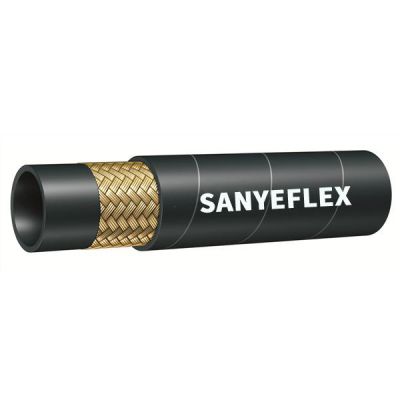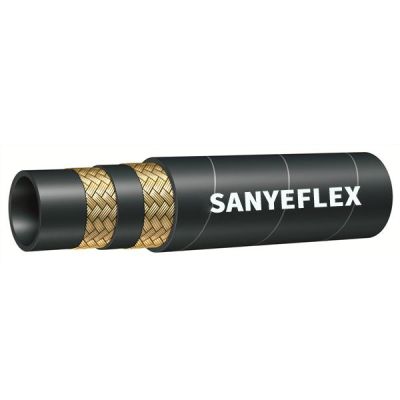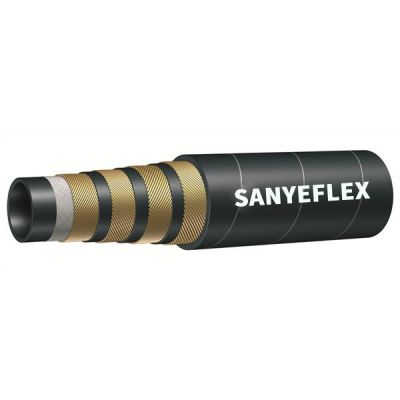Sep. 09, 2024
Hydraulic hoses are critical components in heavy machinery, responsible for transmitting fluid power that keeps everything running smoothly. Whether you're working with excavators, bulldozers, or agricultural equipment, hydraulic hoses are the lifeblood of these machines. But not all hydraulic hoses are created equal, and choosing the right one is crucial to ensuring performance, safety, and longevity in demanding environments.
Hydraulic hoses are flexible tubes made from synthetic rubber, thermoplastic, or other materials, designed to carry hydraulic fluids (like oil, water, or air) between components in a hydraulic system. They act as conduits, transmitting pressurized fluid to power mechanical movement in machinery.
Heavy machinery often uses hydraulic systems to operate lifts, arms, or attachments. The pressure within these systems can be extremely high, sometimes exceeding 6,000 psi, so the hoses used must be durable, reliable, and able to withstand intense conditions.
Hydraulic systems operate based on the principle of fluid dynamics. When fluid is pressurized inside a sealed hydraulic system, it can generate force that moves mechanical components. This is how an excavator’s arm lifts, how a forklift raises a pallet, or how a bulldozer’s blade moves.
Transporting fluid: They carry hydraulic fluid from the pump to various actuators (cylinders, motors, etc.).
Absorbing shocks and vibrations: Flexible hoses dampen mechanical shocks and vibrations, helping prevent damage to other components.
Accommodating movement: Hoses allow for movement between different parts of machinery, such as the pivoting arm of an excavator or the flexible joint of a loader.
There are several types of hydraulic hoses used in heavy machinery, each designed for specific pressures, temperatures, and applications. The main types include:
Braided hoses have one or more layers of braided wire or textile reinforcement. They are commonly used in medium-pressure applications and offer flexibility, making them suitable for equipment that requires movement.
Common Applications: Agricultural machinery, forklifts, and medium-duty construction equipment.
Pressure Range: Typically up to 5,000 psi.
Spiral hoses have multiple layers of wire spirals for reinforcement, making them stronger and more suitable for high-pressure applications. These hoses are generally less flexible than braided hoses but offer higher pressure ratings.
Common Applications: Heavy-duty construction equipment, mining machinery, and high-pressure systems.
Pressure Range: Up to 6,000 psi or more.
3. Thermoplastic Hydraulic Hoses
Thermoplastic hoses are made from materials such as nylon or polyurethane and are lighter and more resistant to chemicals than rubber hoses. They are used in situations where weight is a factor or in applications that involve exposure to harsh chemicals.
Common Applications: Aerial lifts, agricultural sprayers, and high-pressure washing equipment.
Pressure Range: Varies but can be up to 5,000 psi.
4. Suction and Return Hoses
These hoses are designed for low-pressure applications and are used to return hydraulic fluid back to the tank or to draw fluid into the system. They have a thicker wall for durability and are usually made of flexible rubber.
Common Applications: Suction lines and return lines in hydraulic systems.
Pressure Range: Low pressure (below 300 psi).
The materials used to construct hydraulic hoses play a key role in determining their flexibility, durability, and chemical resistance. Common materials include:
1. Synthetic Rubber
Rubber hoses are widely used for their flexibility and resilience. Rubber can handle a wide range of temperatures and is resistant to wear and abrasion, making it ideal for heavy-duty applications.
2. Thermoplastic
Thermoplastic hoses are lighter than rubber and have excellent chemical resistance. They are often used in applications requiring high fluid cleanliness or resistance to harsh environments.
3. Stainless Steel
Some hoses use stainless steel reinforcements for additional strength and pressure resistance. These hoses are ideal for use in high-pressure applications where reliability is crucial.
Choosing the right hydraulic hose for heavy machinery is critical to ensure optimal performance and safety. Here are the key factors to consider:
1. Pressure Rating
Each hydraulic hose is rated for a specific pressure range, typically measured in PSI (pounds per square inch). For heavy machinery, you’ll need hoses rated to handle the maximum pressure of your system. Always choose a hose with a higher pressure rating than the system's operating pressure to provide a safety margin.
2. Temperature Range
Heavy machinery often operates in extreme conditions, from freezing cold to intense heat. Hoses must be able to withstand the operating temperatures of the hydraulic fluid as well as the external environment. If your machinery is used in cold climates or near hot engines, ensure that the hose material is suited to those temperatures.
3. Fluid Compatibility
Not all hydraulic hoses are compatible with every type of hydraulic fluid. Some fluids, especially those with synthetic additives or chemicals, can degrade certain hose materials over time. Make sure the hose material is compatible with the hydraulic fluid you are using.
4. Abrasion Resistance
Heavy machinery is often used in rugged environments where hoses can rub against metal, concrete, or other abrasive surfaces. Choosing hoses with abrasion-resistant covers will extend their life and reduce the risk of failure due to wear and tear.
5. Flexibility
In many heavy machinery applications, the hoses must be flexible enough to move with the equipment. If the hose is too rigid, it could crack or wear out prematurely. Spiral hoses tend to be stiffer, while braided and thermoplastic hoses offer more flexibility.
Previous: Hydraulic Hose Selection: A Complete Guide
Next: Everything You Need to Know About Hydraulic Hose Standards
Our Customer
Tel.: +86 400 0318 111
Email: admin@sanyeflex.com
Add.: #218 Zhongke Street, High-tech Zone, Hengshui City, Hebei Province, China



